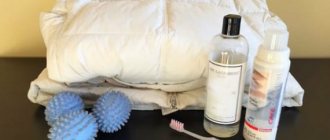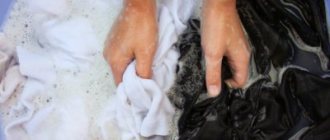How to wash a blouse so that it becomes clean and the item itself is not damaged depends on a number of factors.
Most of the models of this women's clothing are made from delicate fabrics, have a complex cut and require appropriate handling.
How to wash a blouse (white, silk, etc.) in a washing machine, what to do if the item shrinks after washing? You will find answers to these and other questions in the article.
Processing in a washing machine
Most blouses can be machine washed. The exception is those that are sewn from chiffon, natural silk or have complex decor . Only items without damage can be sent for washing. Stains are removed in advance.
Mode
For blouses, the choice of washing mode is almost always limited to “delicate”.
Exceptions may be:
- blouses sewn on the principle of men's shirts, and containing only cotton - “cotton”;
- made of dense synthetics - “synthetic”;
- from artificial silk - to “silk”.
Temperature
The main source of information regarding temperature selection is the product label. It indicates the temperature indicator, which is recommended by the manufacturer itself, and which cannot be exceeded.
The washing temperature is determined taking into account the density of the material: the thinner the fabric, the lower the temperature should be set.
Limit: from +30ºС to +60ºС when it comes to thick white shirts . Taking this information into account, after the desired mode has been selected, the value of the indicator should be adjusted.
Spin
You should not set high spin rates, even for cotton fabrics. Intense exposure can damage the material and lead to deformation.
It is advisable to wash any blouse on a minimum spin cycle . Or without it - if the matter is thin. And do not use the “drying” function.
The blouse, after it is taken out of the washing machine, should not be practically dry - this is harmful to the material.
Detergent
Powders and gels are traditionally used for machine washing. When processing blouses, gels are preferable to powders, as they dissolve more easily in water and do not leave sediment . When choosing, you need to consider the color of the blouse.
How long does it take to wash cotton 40?
So, the time for washing cotton in water at 40 degrees will be 1 hour 30 minutes. The mode will last not much longer - 1 hour 50 minutes - when heated to 60 degrees. At a temperature of 95 degrees and a spin speed of 1200 rpm, the waiting time will increase to 2 hours.
Interesting materials:
How much weight should you lose per week? How much buckwheat should you add? How much tulle do you need for a window? How much fabric do you need for curtains? How much fabric do you need for a family bedding set? How long does it take to study to become an interior designer after 11th grade? How many exercises do you need for one muscle group? How long should you cook greens? How many watts of heat are needed per 1 square meter? How much exercise do you need to do to get pumped up?
Hand washing rules
Washing blouses by hand is preferable to machine washing, especially when it comes to thin translucent chiffon blouses or delicate silk ones.
Washing procedure:
- The blouse is inspected for damage. If there are any, defects should be eliminated before washing.
Warm water is poured into the basin.- Dilute the detergent.
- They dip the thing.
- For a better washing effect, the blouse can be soaked for a short time for about 30 minutes.
- The item is washed carefully.
- Rinse.
- Squeeze effortlessly. For delicate fabrics, spinning should be done by wrapping the blouse in a terry towel.
- Sent out to dry.
Is it possible to bleach a white blouse?
Wearing a product made of white wool for a long time causes it to acquire a yellow or gray tint. You can wash the item at home using special household chemicals. But it is possible to effectively remove stains and restore the snow-white color of your favorite blouse using folk remedies.
Most often things can turn gray or yellow from:
- Poor water quality;
- Ineffectiveness of the powder;
- Increased water hardness;
- Washing items with colored items.
It’s a shame to throw away the sweater, but it’s unlikely to be suitable as going-out clothing. Therefore, housewives are often interested in how to wash gray and yellowed things. This can be done if you select chemicals, wash and dry the products according to some simple rules.
Fabric type: what does it affect?
Women's blouses are made from a variety of materials. Each type should have its own approach.
Chiffon
Feminine, weightless and very beautiful chiffon items are recommended to be washed only by hand. The water temperature for such products should not exceed +30ºС.
Regular washing powders are not suitable for such blouses; you must use only products that are intended for delicate fabrics .
Due to the fact that chiffon is a very delicate fabric, it should be washed effortlessly, and only be washed after wrapping it in a terry towel.
You cannot wring out the blouse too much, let alone twist it - the material will not withstand such a test.
Silk
Natural silk is one of the delicate materials that requires care. The following recommendations must be followed:
for washing, choose a gel rather than a powder detergent;- no need to take the item to dry cleaning;
- Do not use bleach, especially with chlorine;
- ironing at low temperature immediately after washing;
- The blouse can be washed at low temperatures – up to +40ºС;
- spin – very carefully, without twisting – it’s better to just let things drain.
Rayon is processed like a synthetic.
Synthetics
A synthetic blouse may lose its shape if not washed correctly. To prevent fabric damage, remember that:
- spin must be set to minimum;
- wash the blouse only after fastening all the buttons, zippers, Velcro and snaps;
- turning inside out is a mandatory ritual;
- the use of stain removers should be limited.
It is advisable to use liquid detergents, as powders can leave unsightly stains on the fabric.
Cotton
A blouse made of cotton fabric is practical and pleasant to the body. It is not difficult to wash it if you follow these recommendations:
- do not tumble dry;
- use stain removers and bleaches with caution;
- spin – up to 800.
Read about how to wash cotton here.
At what temperature?
The washing temperature depends on the type and color of the laundry . White things, especially those made of thick fabric, can withstand temperatures up to 95 0.
But such modes are not recommended to be used often, since cotton can become deformed and the fibers gradually become thinner. Therefore, high temperature is used when stains need to be removed.
Regular washing of white items takes place at 40-60 0 .
It is recommended to soak or boil shirts, towels and other heavily soiled items made of thick fabric first. This will help restore whiteness. Colored linen may fade at high temperatures and the color will fade. To maintain its brightness, it is not recommended to select a mode above 40 0. Only dark and permanently colored items can be washed at 60 0, but not higher.
It is best not to put thin, delicate linen or lace in the machine . They are washed in cool water by hand, preferably with soap. It is also not recommended to machine wash items with fleece or pile.
Features for different color
If several items are sent for washing, and blouses are among them, then the whole pile needs to be sorted. Blouses differ from each other not only in the type and density of the material, but also in color:
Pure white blouses must be washed separately, using detergent for white items. They will emphasize the whiteness and help preserve the color, since they contain bleaching components.- To process black fabrics, you also need a powder or gel designed for products of this particular shade. It will prevent color loss.
- For other colors, any universal powder or gel will do. If necessary, it can also be used to process both black and white blouses, but this is not advisable.
Store-bought whitening products
The easiest way to bleach a blouse at home is to use special products that are sold in stores. There are different types of bleaches, and each type has its own advantages and disadvantages:
- chlorine-containing products instantly return the whiteness of the fabric, but are aggressive to its fibers. Such bleaches cannot be used on wool, silk, synthetics, and cotton fabrics become thinner and tear over time due to repeated treatment with chlorine;
- oxygen-containing bleaches can be used for any type of fabric, but it should be remembered that products in liquid form have a short shelf life, after which they lose their beneficial properties. A significant disadvantage of such bleaches is their high price;
- optical brighteners do not solve the problem as such, but only mask the imperfections of the fabric with the help of special components deposited on its fibers. Such products are suitable for refreshing white things; they cannot cope with stains and persistent yellowness.
Chlorine-containing bleaches restore whiteness well, but are aggressive towards fabric fibers
Whatever bleach you choose, you should always carefully study the instructions for use and act strictly according to them. Ready-made products are convenient to use when you don’t have extra time and need to bleach one or two things.
Universal bleach). Judging by the reviews, many value it not only for its whitening properties, but also for its ability to remove old and difficult stains
If you have to wash often, for example, school blouses, and it’s a pity to spend the family budget on buying bleach, you can just as well use home remedies.
If the item fades
If a blouse fades, then you should not wash it with other things, even of a similar shade. For such a product, the best option is a low water temperature (up to +40ºС) and the use of a high-quality detergent that works even at low temperatures.
If there is only one such blouse, you can wash it with your hands or run the machine with just one item .
An option to cope with shedding is to use special napkins when washing.
They are sent to the drum along with blouses and processed on a delicate mode. For one cycle, 3 such napkins will be enough to absorb excess paint.
Pre-soaking the item for an hour in a vinegar solution (1 tablespoon per 5 liters of water) will help prevent severe shedding of new fabric and fix the paint .
How to properly wash a cotton shirt?
It is optimal to wash the item at a temperature of 40 degrees and a spin speed of 900 rpm. If your washing machine has a delicate wash function, then this is the most suitable mode for a shirt. You can also set the hand wash program or select the “Quick 30” mode.
Interesting materials:
How to remove chewing gum from trousers at home? How to remove chewing gum from a jacket? How to remove chewing gum from laminate flooring? How to remove chewing gum from plastic? How to remove chewing gum from the sole? How to remove gum from polyester? How to remove chewing gum from a cat's fur? How to remove icons and notifications from the taskbar? How to remove an icon in the notification area? How to remove an icon from the taskbar?
Removing stains
Removing stains from blouses is not an easy task. It is advisable to test the selected composition on an inconspicuous area before use.
Coffee
To combat the stain you will need:
- glycerol;
- ammonia;
- water.
Operating procedure:
- Measure ¼ cup of water into a container.
- Add 1 tbsp. l. glycerin.
- Add 1 tsp. ammonia.
- Stir.
- Apply the solution to the stain with a sponge, movements should go from the edges of the stain to the center.
- Leave for 10 minutes.
- Rinse.
- Wash.
Iodine
you cope with iodine stains.
- Pour ¼ cup of water into a container.
- Add 1 tsp. ammonia.
- Pour in 2 tsp. peroxide.
- Mix.
- Using a sponge, rub the stain.
- Rinse the blouse.
- Wash.
Berries
To remove stains you need to prepare:
- glycerin (5 tbsp.);
- egg yolk (1 pc.).
Description of the method:
- Mix both components.
- Apply the resulting mixture to the stain.
- Leave for a couple of hours.
- Rinse with warm water.
Fat
To remove stains from light-colored blouses, prepare the following solution:
- water (1 glass);
- ammonia (1 tbsp).
Procedure:
- Mix 2 components in a prepared container.
- Using a cotton pad, wipe the greasy stain.
- Place a piece of white cotton fabric on top of the stain.
- The affected area is ironed.
Express method for a fresh stain: treat with dishwashing detergent, leave for a quarter of an hour, then wash.
Another simple way to remove oily marks:
- Sprinkle starch onto the stain.
- Rub with a damp towel.
Pen ink
Glycerin and salt should be prepared in advance. In the process of removing stains, 2 solutions will be used.
First solution:
- pour ¼ glass of water;
- add 5 tbsp. l. glycerin;
- mix.
Second solution:
- pour 0.5 l. warm water;
- add 2 tbsp. l. salt;
- stir.
Stain removal:
- Immerse the area of the blouse with the stain in a glycerin solution.
- Leave for 2 hours.
- Dip the stained area of fabric into the saline solution.
- Leave for a quarter of an hour, moving the fabric.
- Rinse.
- Wash.
What to do if the fabric shrinks?
Deformation of the item, in particular shrinkage, may be the result of improper washing or drying. It is not possible to correct the defect in all situations.
If a blouse made of synthetics has shrunk, you can try to restore its appearance in the following way:
Soak the product in cold water.- Leave for a quarter of an hour.
- Load into washing machine.
- Select “delicate wash” in the settings, spin – 400, water temperature – 30.
- Start the wash.
- No powder is added.
A shrunken item made of cotton or mixed fabric can be restored as follows:
- soak in cold water for 15-20 minutes;
- shake off;
- lay out on a horizontal plane, pulling the blouse with your hands so that it regains its shape.
Useful tips on how to carefully and delicately wash a white, black and colored blouse
How to wash a blouse so that it becomes clean and the item itself is not damaged depends on a number of factors.
Most of the models of this women's clothing are made from delicate fabrics, have a complex cut and require appropriate handling.
How to wash a blouse (white, silk, etc.) in a washing machine, what to do if the item shrinks after washing? You will find answers to these and other questions in the article.
Proper drying
After the blouse is washed, it should be dried. It is convenient to do this by hanging it on a hanger. Even if the fabric is wet, it will drain.
It is also possible to dry blouses laid out on a horizontal plane. Blouses are dried on a dryer so that the item does not touch other clothes.
If the street is chosen for drying, then direct sunlight should be avoided . In the room you need to choose a suitable place for drying:
- dry,
- warm,
- with good air access.
You should not try to speed up the process by hanging shirts on radiators or near a fire. While the blouse is still wet, the product should be well straightened to avoid creases.











